Yesterday’s liveblog can be found here. For an overview and analysis of this developing story see our latest podcast.
Please help The Interpreter to continue providing this valuable information service by making a donation towards our costs.
View Ukraine: April, 2014 in a larger map
For links to individual updates click on the timestamps.
For the latest summary of evidence surrounding the shooting down of flight MH17 see our separate article: Evidence Review: Who Shot Down MH17?
Below we will be making regular updates so check back often.
Naro-Fominsk is at least an hour to the south from Kalininets, the location where we had geolocated this video showing rows of parked KAMAZ trucks painted white. Alabino is about 40 minutes to the south from Kalininets, and is the location of the 5th Separate Motor Rifle Brigade. A soldier stationed at the Tamanskaya Division 2nd Guards Motor Rifle Division reported that they had spent several days painting trucks and loading humanitarian aid into them.
Naro-Fominsk is also an area where there is an army base, the 4th Guards Kantemirovskaya Tank Division. But the video does not appear to have been taken at that location.
In any event, the reason why it matters to determine whether the convoy is being handled by the Russian Armed Forces or the Emergencies Ministry [known as MChS or Emercom] is because of concerns that the humanitarian mission may be used as a pretext for a military invasion. The Russian media has been contradictory on this point.
Russian blogger Masha Klyuchitsa has a good analysis of the contradictions on her VKontakte page (translated by The Interpreter)
This is likely the most unusual humanitarian aid convoy. It has no identifying marks, registration numbers on the vehicles — nothing. There are also conflicting reports in the media. RIA Novosti wrote simply about a convoy; on [Defense Ministry] TV Zvezda, it suddenly becomes a convoy of the Emergencies Ministry, although all the Emercom vehicles have license plates and the relevant paint job (there is an archive photo on Zvezda’s site). The site Vesti 24 also writes about Emercom and even shows scenes of the loading of trucks, which can’t be seen in the [RIA] photographs.
In fact, the provenance of the automobiles becomes quite clear from this video [reported earlier by The Interpreter]. It is clear that soldiers are standing next to the convoy, and the license plates have not been removed yet from the KAMAZes. Of course the convoy is not carrying humanitarian aid disguising weapons — for that, they don’t need to go to such great lengths. Most likely, it’s the usual demonstration of force — “you forbid us to deliver humanitarian aid, but we will do this just as we consider necessary.”
Therefore, likely, it’s not Emercom that is taking part, which would seem logical in any event, but the army, although not publicly. There isn’t a word on the Emercom website in the section on the latest information about this convoy.
Photos by RIA Novosti of humanitarian convoy without license plates.
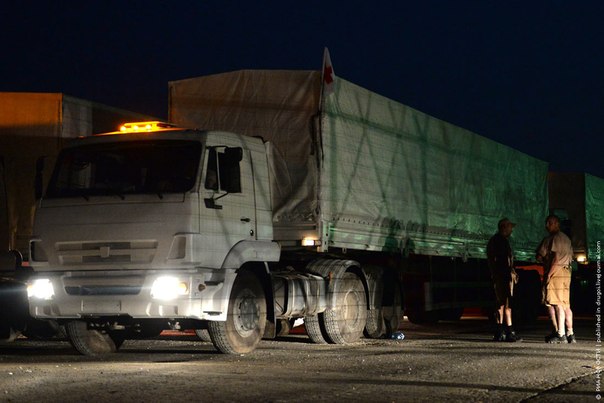
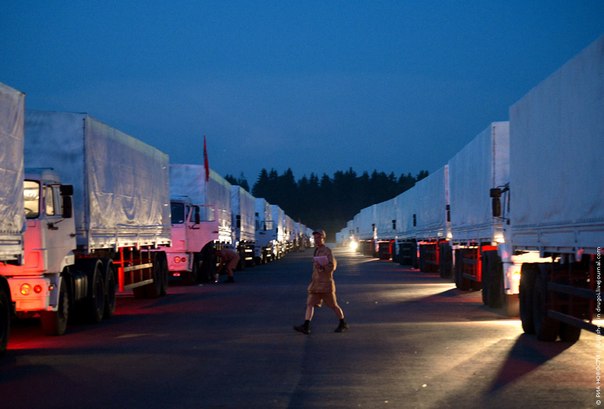
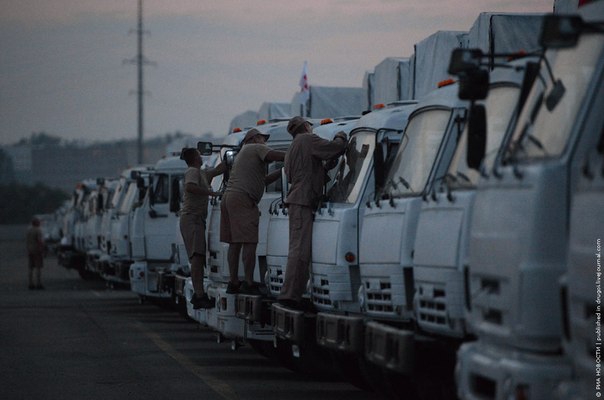
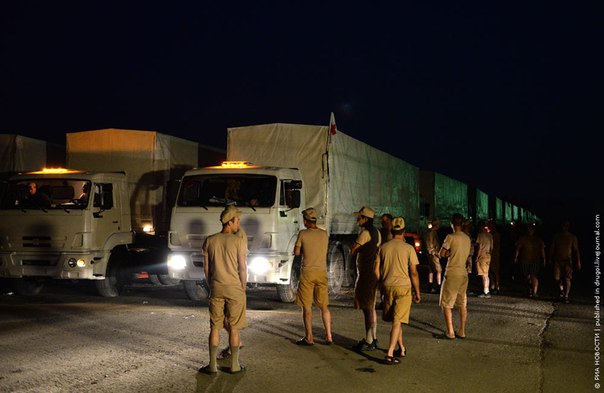
Meanwhile, there are reports that another 15 trucks with humanitarian aid have arrived in Rostov near the Ukrainian border, says RBC.ru.
Authorities say they are prepared to send them to the Donbass, RBC.ru reports, adding that “the Russian Interior Ministry and Emercom will be responsible for the delivery of the convoy.”
Kiev wants the aid to go to Lugansk, and come not only from Russia but the EU and Germany; meanwhile there is fear that Russia will provoke the situation to invade, in a scenario recalled from the Georgian war. The Ukrainians have good reason to fear this, given that Russia has brought armored convoys marked with “peace-keeping” insignia right up to the Ukrainian border over the weekend.
Maxim Grigoryev, head of the working group in the Russian government’s Civic Chamber to provide humanitarian aid to southeastern Ukraine, told RBC.ru that Emercom, with the involvement of the ICRC, could make up the convoy within six hours to deliver the aid.
Yet the local Emergencies Ministry office for the South Region in Rostov didn’t have any information about a humanitarian convoy, and said the regional government was taking care of humanitarian aid, RBC.ru reported.
RIA Novosti reported that the ICRC was waiting to confirm the details with Russia concern the type and volume of deliveries and the transportation and storage requirements.
ITAR-TASS reported August 12 Moscow time that a convoy of 280 trucks had left the suburbs of Moscow for the southeast of Ukraine.
It was reported to carry 2,000 tons of humanitarian cargo including 400 tons of grains, 100 tons of sugar, 62 tons of baby food, 54 tons of first-aid items and medicines, 12,000 sleeping bags, and 69 electrical power generators of various capacity.
TASS reported Putin as stating that in a telephone call with EU Commission President Barroso, he reached an agreement regarding cooperation with the International Commitee of the Red Cross. Russian Foreign Minister Lavrov said the details of the convoy were being worked out with Ukrainian leadership. “I hope that the humanitarian action that we are working out now will not be stopped by our Western partners.”
There was a great deal of confusion today about how Russia would participate in a humanitarian convoy, given that it has appeared to wish to use “humanitarian relief” as a pretext for invading Ukraine. The ICRC made it clear that no armed escorts will accompany its mission in Ukraine.
Meanwhile, we have geolocated the video reported earlier showing numerous trucks painted white and marked with red crosses and the words “medical service.” They were parked next to an S-300 — one of the most advanced anti-aircraft systems Russia possesses — at a military base, being inspected by Russian Military Auto Inspection.
A soldier from the 1117th Air Defense Regiment of the 2nd Guards of the
Tamanskaya Motor Rifle Division reported on the social media network VKontakte that his unit had been busy for several days painting KAMAZ trucks white. His regiment is located in Kalininets, a suburb of Moscow and another nearby town Kobyakovo.
He wrote 11 August (translation by The Interpreter):
“Today we loaded humanitarian aid into KAMAzes [trucks] for
Ukraine. Water, medicines, canned food, baby food, sleeping bags,
electrical generators and various equipment (field kitchens and so on).
There were about 300 trucks, all military KAMAZes, they were painted
white in a few days.“
His account has now been removed from VKontakte.
But his photos of the white-painted trucks and a screenshot of his VKontakte page survived on Twitter.
That information could be put together with the video of the white trucks to geolocate it to Kalininets.
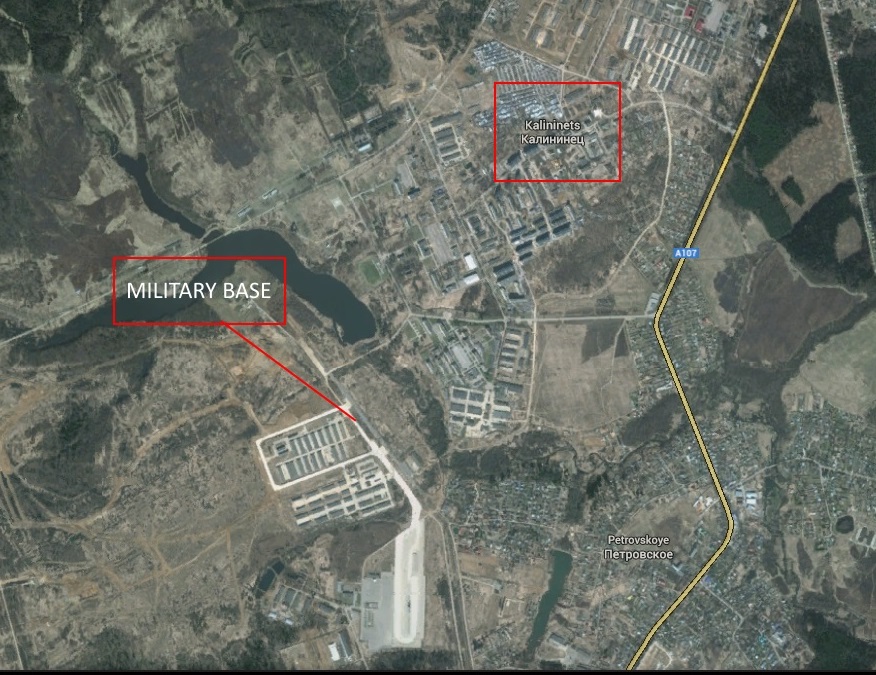
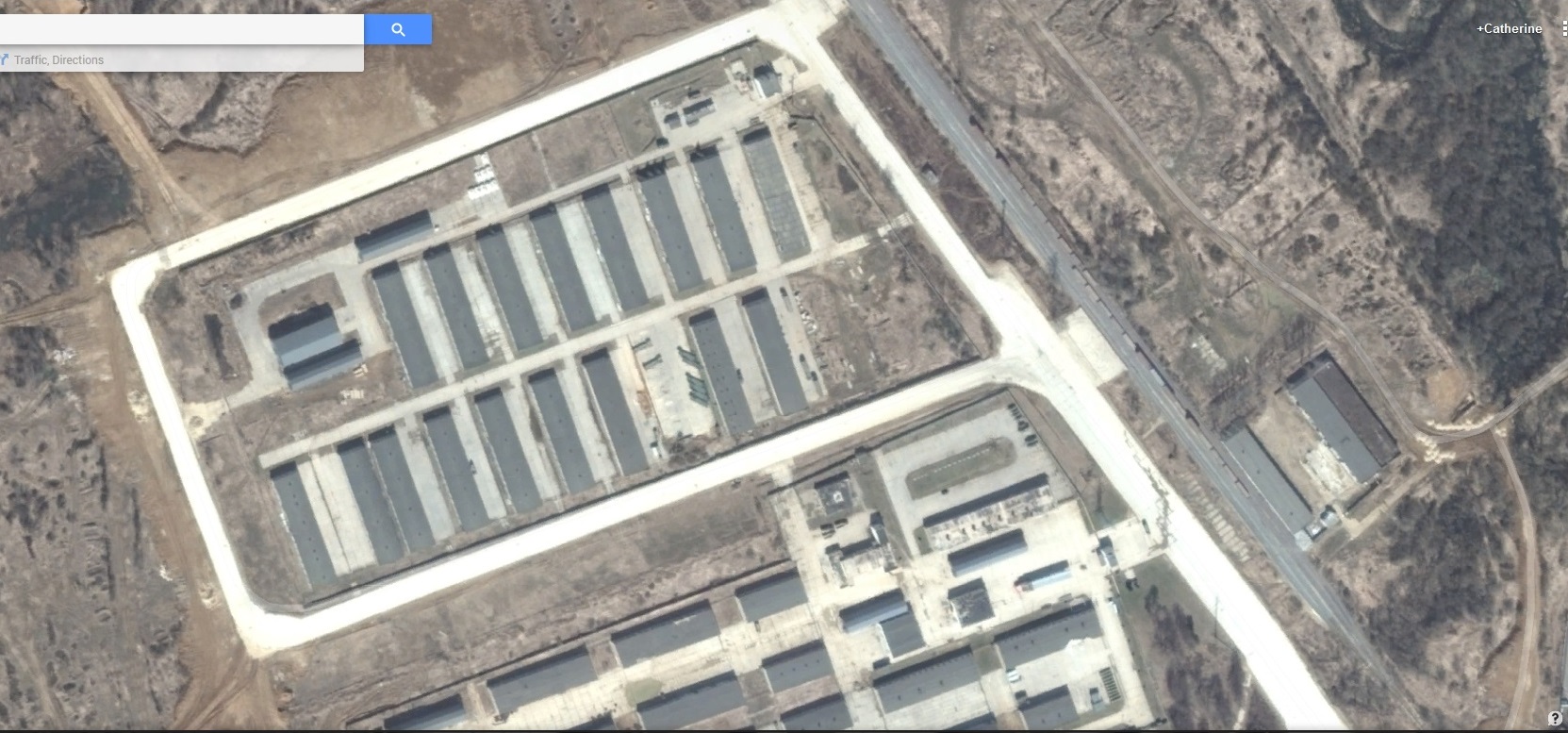
A photo taken earlier published on Google Street View shows a tank at that location practicing for the Victory Day parade, with the rail yard visible behind it.
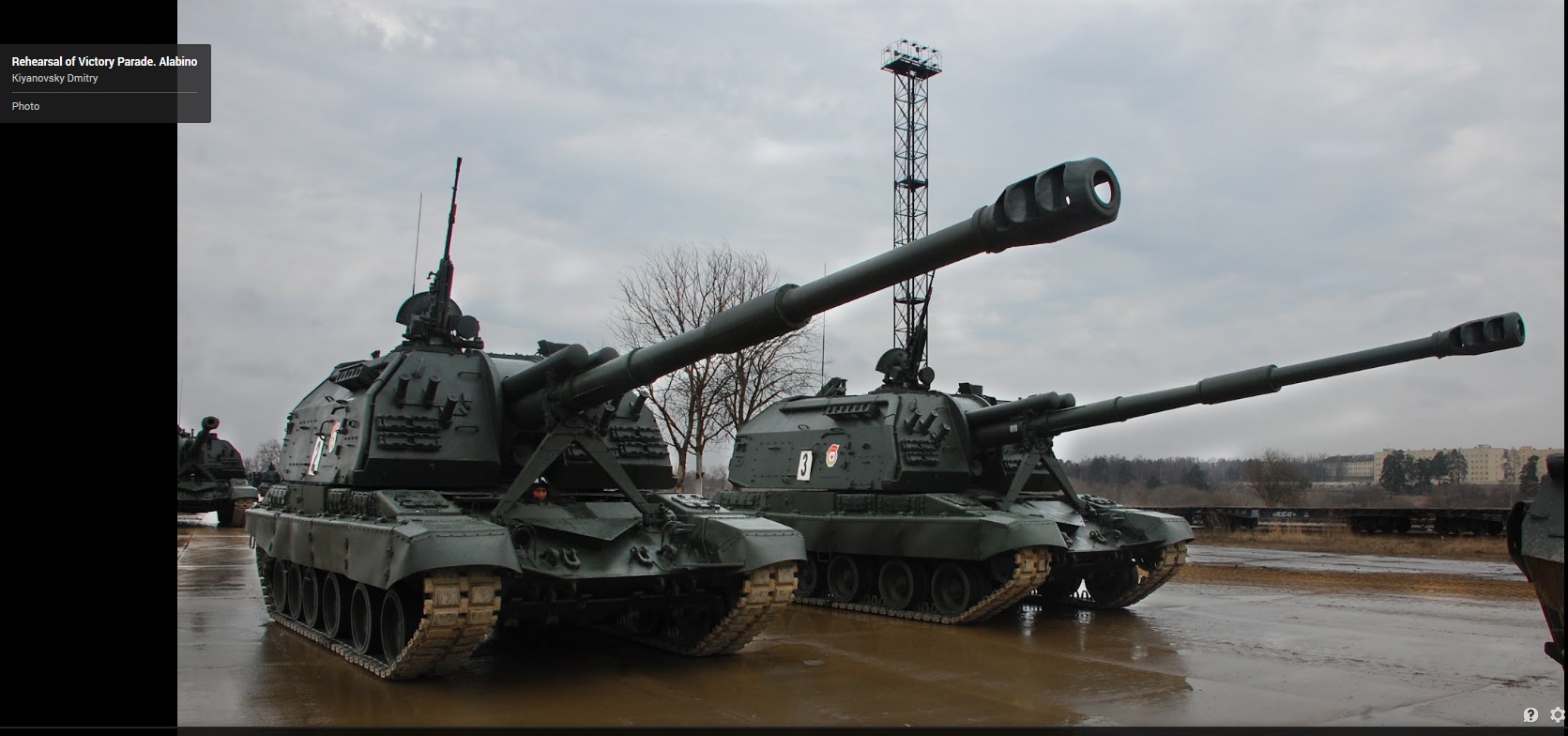
Notice also that the building at 9 seconds in matches this building.

There are a lot of new pictures being spread on social media today which reportedly show more Russian vehicles moving toward the border. The worrying thing is that some of them appear to show advanced anti-aircraft weapons.
For instance this picture was posted by the journalist Saviik Shuster and appears to show an Osa SA-8 missile system:
The SA-8 is designed to operate in conjunction with a larger radar network or independently, and its missiles have a range of 12,000 meters (remember that MH17 was knocked out of the sky while it was at an altitude of 10,000m).
While we can’t geolocate the picture, it does not appear to have been posted on the internet before today.
Several more videos which reportedly show Russian vehicles on the move near the border.
UPDATE: These last two pictures came from the VKontakte page (popular Russian
social media network) of a Russian soldier named Semyon Borisov who says
he is from the 1117th Air Defense Regiment of the 2nd Guards of the
Tamanskaya Motor Rifle Division.
He writes (translation by The Interpreter):
“Today we loaded humanitarian aid into KAMAzes [trucks] for Ukraine. Water, medicines, canned food, baby food, sleeping bags, electrical generators and various equipment (field kitchens and so on). There were about 300 trucks, all military KAMAZes, they were painted white in a few days.“
His account has now been removed from VKontakte.
A screenshot was saved on Twitter.
dozens of white Kamaz trucks and troops with uniforms that say
“Military Auto Inspection.” At the end of the video, however, there
appears to be the radar tower for an S-300 anti-aircraft system:
The vehicle at the end of the video looks like a 5N66M (clam shell) radar system, one of the many things that makes the S-300 one of the most advanced anti-aircraft systems Russia possesses.
We’re still working to definitively locate where this video was taken.
The Committee to Protect Journalists has released a statement saying that another journalist is missing in Ukraine:
The Committee to Protect Journalists is concerned about the safety of Andrei Stenin, Russian photojournalist for the state news agency Rossiya Segodnya (previously RIA Novosti). The agency said it had not heard from Stenin since August 5, when he was reporting on the conflict in eastern Ukraine, including from the cities of Donetsk and Sloviansk. An unnamed source cited by Rossiya Segodnya said Stenin had been abducted by Ukrainian militia and was in the custody of the Ukrainian security service (SBU) in the city of Zaporozhye. The SBU denied the allegation, according to Rossiya Segodnya.
“We call for the immediate release of Andrei Stenin,” CPJ Europe and Central Asia Program Coordinator Nina Ognianova said. “All parties to the conflict in Ukraine must respect the role of journalists and allow them to do their job safely and without fear of retaliation.”
Press freedom conditions in Ukraine, especially in the volatile southeastern regions, have steadily deteriorated in recent months, with journalists being detained, attacked, abducted, and killed, according to CPJ research.
Kyiv Post’s Christopher Miller provides the clearest explanation of the totally-unclear situation revolving around today’s announcement that the International Committee of the Red Cross will run an aid mission into the eastern Ukrainian territory of Lugansk.
Here is the rundown of the confusion:
Earlier today the Ukrainian President agreed to allow the International Red Cross to conduct a humanitarian aid mission in Lugansk. Russia then said that they would be sending their own aid convoy into Ukraine. The initial statements from Kiev and the EU make no mention of this. Since then the ICRC has not released a formal statement, but as we pointed out in our previous update a member of the ICRC office in Kiev also was unaware of any Russian participation in the efforts.
Since then, Ukraine now says Russia will “participate” but it’s not clear what “participate” means. Miller clears some of this up:
A senior official in the [Ukrainian] presidential administration told the Kyiv Post that “Russia will have a formal part, but there will be no Russian [military] forces, no soldiers.”
Ukraine had previously objected to Russian involvement in relief efforts, fearing that a humanitarian mission could be used as a cover for an invasion of Russian soldiers…
Still, the senior presidential administration official said that with Russia participating in the convoy the risk of war between the countries “goes up.”
There have been recent threats of Russian incursions into the country. On Friday, a humanitarian convoy accompanied by Russian military personnel and military vehicles advanced toward the Ukrainian border with the intention of crossing into the country late on Aug. 8, but it stopped short of the frontier, said Deputy Chief of the Presidential Administration Valeriy Chaly.
It’s worth reading Miller’s breakdown of today’s statements.
The White House has released their official statement, which echoes what they said on August 9th:
The President spoke this morning with Ukrainian President Petro Poroshenko about the ongoing crisis in eastern Ukraine. President expressed his strong support for Ukraine’s sovereignty and territorial integrity. The two leaders agreed that any Russian intervention in Ukraine without the formal, express consent and authorization of the Ukraine government would be unacceptable and a violation of international law. President Poroshenko also noted the continued shelling of Ukraine’s territory from Russia. President Poroshenko updated the President on his engagement with the International Committee of the Red Cross (ICRC) on the effort to deliver multilateral humanitarian aid to the distressed populations in eastern Ukraine. The President noted the urgency of such humanitarian efforts and encouraged President Poroshenko to continue to exercise restraint and caution in military operations in order to avoid civilian casualties. In light of the ongoing violence and instability, the President and President Poroshenko agreed that all parties should prioritize diplomatic efforts toward finding a political resolution to the crisis.
At the very least we see that Kiev is not granting Russia “the formal, express consent and authorization of the Ukraine government” to intervene in Ukraine as part of the Red Cross mission. Kiev’s understanding is that there will be no Russian troops involved in this mission.
But what is Moscow’s understanding of what took place today?
The Ukrainian president’s office has released another statement today regarding a phone conversation with US President Barack Obama and concerning an agreed-upon humanitarian aid convoy in Luganks. Below is a translation provided by The Interpreter:
The President of the USA expressed his support for the actions of the President of Ukraine, in particular, the initiative of Petro Poroshenko for an international humanitarian mission for Lugansk under the aegis of the International Committee of the Red Cross with the participation of the EU, Russia, Germany and other partners. Barack Obama confirmed the intention of the USA to take an active part in the international humanitarian mission.
Petro Poroshenko thanked the USA for the bi-party initiative in the US House of Representatives of the USA Congress to present the Ukrainian Assistance Act on issues of security which, in the opinion of the President of Ukraine, testifies to the real support of Ukraine on the part of the USA. President Poroshenko expressed hope that this Act will be supported by Congress people and senators, and also signed by the President of the USA in the near future.
Petro Poroshenko and Barack Obama discussed the issues of security in the ATO zone.
The presidents of the USA and Ukraine agreed to a bilateral meeting at the NATO summit which will take place in Newport, Wales, UK, on 4-5 September of this year.
It’s unclear if this clarifies the nature of Russia’s involvement in such a mission. By “participation” does that mean that the countries named above will supply the Red Cross with aid which the Red Cross alone will distribute? Or are the Russians going to send their own vehicles into Ukraine, either with, or in addition to, the ICRC convoys?
This might clear some things up:
We provide the translation of that article:
Representatives of the mission of the International Red Cross (ICRC) in Kiev do not know anything about coordination of the sending of a Russian humanitarian convoy to Ukraine, Ashot Astabatsyan, representative of the ICRC, told RBC.ua.
Meanwhile, the Ukrainian Interior Ministry has refused to comment on the statement from the Kremlin press service.
We will recall that earlier, the Kremlin reported that in accordance with an agreement reached by Russia, a humanitarian convoy is being sent to the east of Ukraine. RF President Vladimir Putin announced this in a telephone conversation with Jose Barroso, president of the European Committee. Putin emphasized that the operation will proceed with coordination with representatives of the ICRC.
Interfax tweets that the ICRC is preparing a statement. But as we pointed out in a previous update, just because the ICRC and the Ukrainian government have one understanding of what is supposed to transpire does not mean that Russia has the same understanding.
The Russian propaganda outlet RT first made the claim that a humanitarian mission to Lugansk has been agreed upon between Russia, Ukraine, and the International Committee of the Red Cross (ICRC):
“With careful optimism, I can now say that, I think, all possible and impossible pretexts have been dismissed. I hope that in the very nearest future this humanitarian action will take place under the authority of the Red Cross,” Lavrov said.
“We’ve agreed on all details with the Ukrainian leadership,” the Foreign Minister declared.
He also expressed hope that “Western partners won’t put a spoke in the wheel and will think about the people who are badly in need of water and electricity,” Lavrov said.
Russia, together with the International Red Cross Committee, is sending a humanitarian convoy to Ukraine, Russian President Vladimir Putin told the head of the European Commission Jose Manuel Barroso, according to the president’s press service.
United States Ambassador to the United Nations, Samantha Power, has deemphasized Russia’s role in providing aid, suggesting that the ICRC will deliver the aid, while highlighting Moscow’s role in facilitating any aid mission:
But now Pravda is reporting that Putin will send his own convoy into Ukraine, apparently in addition to the one sent to Ukraine via the ICRC.
The Interpreter translates the Kremlin’s statement:
A telephone conversation has taken place between Vladimir Putin and EU Commission President José Manuel Barroso.
The situation in Ukraine was discussed. The head of the Russian state provided his assessment of the reasons for the emergence of a crisis in this country. He accentuated the catastrophic consequences of the military operation conducted by the Kiev authorities in the south-eastern regions and the need for urgent delivery of humanitarian aid to the conflict zone.
It is noted that the Russian government in cooperation with representatives of the International Committee of the Red Cross is sending a humanitarian convoy to Ukraine.
Vladimir Putin and José Manuel Barroso also discussed several relevant issues of cooperation between Russia and the European Union, including in the context of the signing of Ukraine of the Agreement on Association with the EU and the taking by Russia of retaliatory measures to the sanctions of the West, which ban the important of agricultural products from the EU countries.
This statement suggests that Russia is sending an aid convoy to Ukraine. But Ukraine’s official statement makes no mention of a Russian convoy — only an ICRC one (translated by The Interpreter):
Ukrainian President Petro Poroshenko held a telephone conversation with EU Commission President José Manuel Barroso.
During the course of the conversation, the situation in the Donbass was discussed, and also the initiative of the President of Ukraine to implement an international humanitarian mission for Lugansk under the aegis of the International Committee of the Red Cross (ICRC).
Petro Poroshenko announced his readiness for a multi-lateral international discussion of the settlement of the situation in the Donbass in the Normandy or Geneva format. The head of state expressed the wish that the “Ukrainian question” be put on the agenda and receive due attention during the next meeting of the European Council 30 August of this year.
EU Commission President José Manuel Barroso supported the initiative of the President of Ukraine for a humanitarian mission and the clear position of Ukraine, that it must be carried out in accordance with international law. He also reported that the European Union is prepared to allocate 2.5 million euro for humanitarian aid for Ukraine. Furthermore, he called for the creation of a special coordinating mechanism for providing humanitarian aid and settling migrants.
The President of Ukraine assured the President of the European Commission of his adherence to the intention to bring to life a peace plan on these principles: bilateral ceasefire with monitoring and verification of the OSCE; release of hostages; monitoring of the Ukrainian-Russian border for the cessation of deliveries of fighters and armaments; and a political dialogue without any additional conditions.
President Poroshenko and President Barroso also discussed the time-table for implementation of the Agreement of the Association with the EU, questions of energy cooperation and resumption of negotiations on gas in the trilateral format of EU-Ukraine-Russia.
Petro Poroshenko invited José Manuel Barroso to visit Kiev. The President of the European Commission thank him for the invitation and said that he is reviewing the possibility of visiting Kiev for participation in the conference “Yalta European Strategy” in early September.
The EU’s own statement on the matter, however, seem to directly contradict statements made by Russian Foreign Minister Sergei Lavrov:
Speaking with President Putin, President Barroso said that the EU would join in international efforts to assist people in need as a result of the conflict. President Barroso expressed concern at the gathering of Russian troops near the Ukrainian border, as well as the continuing flow of arms, equipment and militants from Russian territory, which run counter to efforts towards de-escalating the crisis. President Barroso warned against any unilateral military actions in Ukraine, under any pretext, including humanitarian. President Barroso also appealed on Russia to use its influence to ensure that civilian populations could safely and freely leave areas of conflict controlled by illegal armed groups.
So is Russia going to use this agreement to send an invasion force into Ukraine in the guise of a humanitarian mission? It’s possible. As we’ve been warning both on our website and in interviews, Russian armor on the border with Ukraine is already marked with “peacekeeping” emblems. Now NATO is warning today that any humanitarian mission from Russia may just be a ploy to help the separatists, and there is a “high probability” of an outright Russian invasion.
NATO Secretary-General Anders Fogh Rasmussen said there was still no sign Russia had withdrawn the troops it had massed at the frontier, which prompted warnings from the West last week that President Vladimir Putin could be planning to invade.
Asked in a Reuters interview how high he rated the chances of Russian military intervention, Rasmussen said: “There is a high probability.”
“We see the Russians developing the narrative and the pretext for such an operation under the guise of a humanitarian operation and we see a military buildup that could be used to conduct such illegal military operations in Ukraine,” he said.
NATO believes any Russian humanitarian mission would be used as a pretext to save the rebels, who are fighting for control of two provinces under the banner of “New Russia”, a term Putin has used for southern and eastern Ukraine where Russian is spoken.
Putin’s favorite tactic is to change the definition of words when it enters into international agreements. “Terrorists” become “protesters” (at least in Ukraine — in Syria, and Moscow, it’s the other way around) and “ceasefire” means whatever benefits Russia’s allies, and so it’s not unthinkable that an ICRC aid convoy could easily be understood by Moscow as an excuse to send Russian “peacekeepers.”
In a statement on August 5th, the United States delegation to the United Nations made it clear
that the US is demanding independent international monitors at the
border area and expanded access for existing humanitarian missions. The message from the international community is unified, but the Kremlin might twist their words anyway to justify invasion.
It’s still unclear whether an outright Russian invasion will happen. We actually argue against the chances of an outright invasion in our latest podcast. But it could happen, and a slow “drip-drip” invasion is already happening. How this new agreement will play into that one way or the other remains unknown.
Ukrainska Pravda reports (translated by The Interpreter):
A discussion on the implementation of the Association Agreement between Ukraine and the EU will be held in Moscow on Tuesday and Wednesday, reports Interfax-Ukraine, citing an anonymous EU representative.
According to the agency’s sources, the negotiations will take place at the level of deputy foreign ministers.
According to the source, this discussion will then be continued in Kiev and in Brussels the week later.
The source noted that the European Union, as has been the case since the beginning, will participate in these negotiations as an observer.
These meetings are focused on the preparation of the ministerial talks on September 12. At these, the EU will be represented by the European Commissioner for Trade, Karel de Gucht.
As has been reported, Prime Minister Arseniy Yatsenyuk is doubtful that an agreement with Russia on this matter can be reached.
Russia insists that, after the implementation of the agreement on a free trade zone between Ukraine and the EU, their economy may suffer.
The Ukrainian National Security and Defence Council (SNBO) has called on the residents of Donetsk and Lugansk to leave as soon as possible.
Speaking a briefing today the SNBO spokesman, Andrei Lysenko, told reporters that:
“The anti-terrorist operation will continue. Peaceful residents should leave the cities of Donetsk and Luhansk just before these are freed.”
The Ukrainian military has established humanitarian corridors for refugees to leave both cities. The call today echoes one made on August 4 for civilians to leave areas under separatist control.
Meanwhile Interfax-Ukraine reports that the Donetsk mayor’s office has reported shelling and gunfire in the city.
They also report further damage to the electrical infrastructure of the city:
Two electric substations on the grounds of the Tochmash plant remain without power, the spokesperson said. For this reason, residents in the Pryvokzalny neighborhood of the Kuibyshevsky district, and in the Kyivsky and Putylivsky districts – in all, around 5,000 people living in tower blocks and private houses – remain cut off from electricity.
“Also there is no power in the buildings of the regional pension fund, a local tax inspectorate in the Kyivsky district and the Tochmash plant. Power engineers from DTEK High-Voltage Electricity Transmission Networks will be able to start repairing the damaged power transmission line after the hostilities end,” the spokesperson said.
“’No state or regime goes to war firmly convinced that it will lose
it,’ Andrey Piontkovsky says, and Vladimir Putin is no exception”
In today’s Window on Eurasia, the Russian commentator Piontkovsky argues
that the logic behind the MAD (Mutually Assured Destruction) which
prevented military escalation during the Cold War, is no longer upheld
in the modern world. The West is divided on how to respond to Russian
use of a nuclear strike.
This, however, does not mean that Russia
aspires to use this advantage to destroy the Western powers, according to Piontkovsky.
“[Putin’s]
goals are ‘significantly more modest: the maximum extension of the
Russian World, the destruction of NATO, and the discrediting and
humiliation of the US as the guarantor of the security of the West.’”
The destruction of NATO and the maximum
extension of the Russian World can be seen as interconnected. Because
Latvia and Estonia are NATO members, and also part of Putin’s ‘Russian
World’ territory, a covert or open invasion by Russia would require NATO
to declare war. If they don’t, this would mean “the end of NATO and the
end of the US as a world power and the complete political dominance of
Putin’s Russia […] in the entire European continent.”
According to
Piontkovsky, NATO members are less likely to uphold the alliance’s
Article 5 “in which an attack on one is an attack on all,” if Putin
chooses to launch a “very limited nuclear strike” on an area that
western Europeans and United States citizens don’t feel too connected
too.
“Putin therefore is “convinced that he can outplay [Western
countries and leaders] in potential military conflicts which will arise
on the path to the realization of the great idea of the Russian World
despite the fact that Russia” is much weaker in conventional arms than
NATO and does not have an advantage over the US in nuclear ones.”
The main goal of the Ukrainian governments anti-terrorism operation is to drive a wedge between the self-declared Donetsk and Lugansk ‘People’s Republics’ (the DPR and LPR, respectively) which would also isolate the city of Donetsk from its supply routes to Russia. That strategy is clearly illustrated in the maps being drawn by the website Liveuamap. While the area in grey here is far more disputed than this maps otherwise bright colors may suggest, the point is that Donetsk is more isolated with each passing day. Here is a snapshot taken today:
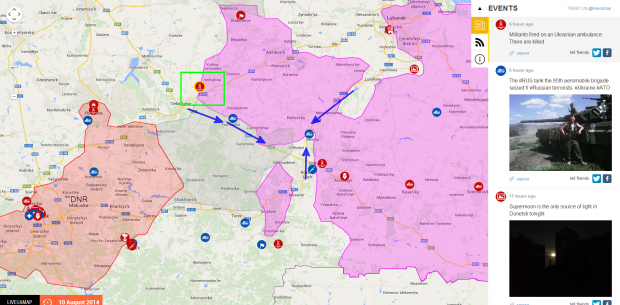
We have highlighted one area with a green box. That is a report that a Ukrainian ambulance was fired on today. Casualties are reported:
The general theme of the fighting in the last few days seems to be that the Ukrainian military is still advancing near Donetsk but is under relentless assault by Russian artillery and Russian-supplied tanks, armor, and anti-aircraft missiles in the southeast of the LPR. In essence, there is a kind of race at the moment, with Russian-backed fighters pushing in the southeast of the combat area while Ukraine’s ATO chips away at Donetsk in the center and the west.
At this moment, however, it still seems that the ATO is advancing faster than the separatists.
Dmytro Tymchuk of Information Resistance writes on his Facebook page that Ukrainian checkpoints near the villages of Makarovo and Kamyshnoye, in the Lugansk region, were shelled from Russian territory last night. Later on, Ukrainian security officers in the border area were shelled twice.
Elsewhere in the ATO zone, an ambulance, evacuating wounded from a checkpoint, was struck by mortar fire. Tymchuk notes that “according to preliminary data, there were losses.”
There were also a number of attacks near the separatist-held city of Lugansk.
According to Tymchuk, Ukrainian positions near the village of Stukalova Balka, to the north of the city, came under mortar attack for the course of an hour. A little further north, positions close to the village of Peski were attacked by a group of separatist fighters. The attack was reportedly repelled.
Meanwhile to the south of the city, Lugansk Airport, which is under government control, was fired on twice with BM-21 Grad rockets. Tymchuk says that there were no losses of personnel but three military vehicles were knocked out.
The destruction dealt to Lugansk Airport of the past few months is made clear in this video uploaded to YouTube last night:
This morning, the website of the Donetsk mayor, Oleksandr Lukyanchenko, announced that 106 prisoners had escaped penal colony number 124 in Donetsk after the facility was struck by shells, killing one prisoner.
The prison, in the Kirovsky district of Donetsk, was struck by a shell late yesterday evening. One prisoner was killed. The staff headquarters and an electrical substation in the prison were also damaged by the blast. A riot broke out in the prison and 106 prisoners escaped.
Novosti Donbassa specified that the attack had taken place at around 22:00, with 5 shells landing on the grounds of the prison, 3 of which struck the housing unit. They reported that 5 prisoners had received injuries of “medium severity” and that two prison employees had also been wounded. All casualties were being treated in the prison hospital.
Novosti Donbassa later reported that 34 of the escaped prisoners had been returned to detention.
The State Penitentiary Service announced that the institution intended that all remaining escapees be returned to serve the rest of their sentences once the situation was stabilised.
Work is under way to locate the prisoners and restore electrical power to the prison, which is currently running on reserve power.
The prison service stressed that the situation in the prison was difficult, but manageable, noting that food and water were still being provided for. The prisoners have reportedly been transferred to specially equipped shelters and are receiving psychological care to deal with the stress of the shelling.